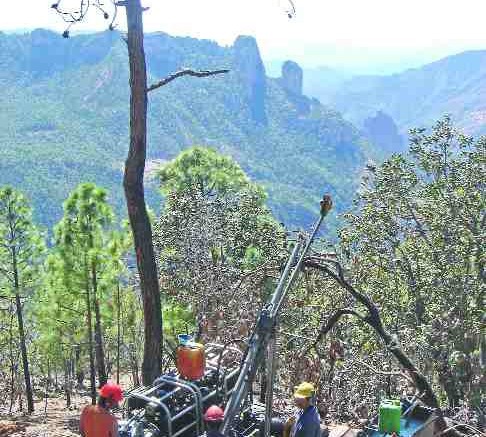Sean Boyd, vice-chairman and chief executive of Agnico-Eagle Mines (AEM-T, AEM-N) is feeling pretty chuffed these days.
“We have half a billion in cash, five mines under construction and our gold output is going to increase five times in the next three years,” he says proudly.
It’s an enviable spot to be in and it just got even better. New gold and silver reserve estimates at Agnico-Eagle’s Pinos Altos property, in northern Mexico, have pushed the company’s plans ahead for a gold mine on the site.
Recent drilling revealed gold ounces in reserves have increased 21% and silver reserves 18% from the company’s earlier estimates released in February.
Pinos Altos, 280 km west of Chihuahua, the state capital, is in the Sierra Madre gold belt, one of the most active gold and silver mining districts in the world with seven major projects and mines.
Extending from northwest to southeast through Mexico from the U.S., the rugged Sierra Madres have a great wealth of minerals, including iron ore, lead, silver and gold.
“It’s clearly a place where there has been a lot of successful exploration, so that’s why we were excited about having a great asset in a great part of the world,” says Boyd from his base in Toronto.
But it’s not just the rich geology that appeals to Agnico-Eagle. Low operating costs, political stability (in its first 12 months since the elections in July 2006, the new government under President Felipe Calderon has attempted to increase competition and attract foreign investment) and mining-friendly regulations, made Mexico a logical choice to help the company broaden its geographical footprint. Canada’s largest gold producer also has operations in Finland and the United States. Pinos Altos will be the company’s sixth gold mine.
“Our geologists were very excited about the exploration potential of Pinos Altos when they first looked at it,” says Boyd of the 110-sq.-km property. “The geologists are bang on with their initial assessments.”
Current reserves at Pinos Altos total 2.2 million oz. gold from 20 million tonnes of ore in probable reserves grading 3.5 grams per tonne, a 13% increase in gold grade over the previous reserve estimate in February. The Pinos Altos deposit also includes about 65.7 million oz. silver in the reserve category, an increase of roughly 10 million oz. over the previous estimate.
The February feasibility study projects an after-tax rate of return of 18.3%, based on a gold price of US$530 per oz. and a silver price of US$9.59 per oz.
Annual production is expected to average about 150,000 oz. gold at average total cash costs of US$240 per oz., including royalties and net of byproduct silver credits. Annual silver production is forecast to average over 2 million oz. per year.
Initial production is likely to begin in the second quarter of 2009. The company says it has all the necessary land agreements with the four local agricultural groups in the area and is currently negotiating additional surface rights with the underlying royalty holder. If those negotiations are unsuccessful, Boyd says, modifications to the proposed mine plan contained in the base case feasibility study will be implemented.
About 60% of the Pinos Altos mineral resource is located in the Santo Nino zone along a regional fault that holds a number of other known deposits in the area. This Santo Nino zone has a thickness of up to 45 metres over a length of 2 km, and a vertical extent that runs more than 750 metres. It remains open to the west and at depth.
The mine will have a conventional milling operation of 4,000 tonnes of ore per day and a heap-leach circuit reaching peak production rates of 2,500 tonnes of ore per day.
Agnico-Eagle says the ore is non-refractory, yielding excellent gold recoveries of greater than 95% with conventional cyanidation processing. Silver recoveries are expected to average 50%.
Overall mine-site operating costs are forecast to average US$39 per tonne, with construction capital costs of US$190 million and average sustaining capital expenses of roughly US$3 million per year. Agnico-Eagle estimates that the project will be completely funded from existing cash and cash flows.
In March 2005, Agnico-Eagle signed an option agreement with Industrias Peoles (IPOAF-O, PENOLES-M) to purchase the Pinos Altos property. It exercised that option in March 2006, paying about US$80 million in cash and stock.
Agnico-Eagle posted a US$37.8-million profit for the second quarter of 2007, up slightly from US$37.1 million in the year-earlier period. Cash provided by operating activities in the second quarter soared to US$79.8 million, up from US$49.5 million in the same quarter last year.


Be the first to comment on "Agnico-Eagle to move ahead with Pinos Altos"